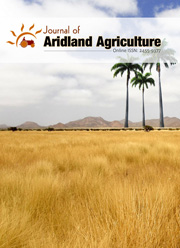Carum carvi mediated green synthesis of copper nanoparticles and its effect on Solanum lycopersicum seedlings
DOI:
https://doi.org/10.25081/jaa.2023.v9.8191Keywords:
Copper nanoparticles, Solanum lycopersicum, Carum carvi, Green-SynthesisAbstract
The present study aims to synthesis the copper nanoparticles (CuNPs) and their effect on the biochemical and physiological characteristics of Solanum lycopersicum. The results exhibited the color change in the Carum carvi aqueous extract from clear deep brown to a greenish color and this observation indicated the green-biosynthesis of CuNPs by reduction of Cu+ to Cu0. Also, the absorbance broadening band for the green-biosynthetic CuNPs appeared at the 340 nm wavelength using UV-Vis but the C. carvi aqueous extract not showed any peaks at this wavelength. SEM analysis exhibited the micrographic surface morphology and the shape of the green-biosynthetic CuNPs with a scan area of 50 μm and showed the spherical shape particles of CuNPs aggregation. The three-dimensional image and the surface morphology of green-biosynthesized CuNPs and C. carvi aqueous extract were examined using AFM analysis that showed the surface of C. carvi aqueous extract was 45.5 nm size with non-homologus and irregular form of distribution, but the green-biosynthesized CuNPs were 12.4 nm size in nanoscale with regular and homogenous distribution form. The results also showed that the effect of bio-synthesized copper nanoparticles was evident on the S. lycopersicum seedlings fresh and dry weight according to the different reading times after treatment with nanoparticles. Also, the concentration of 2.5 mg/mL (CuNPs) showed a significant increase in the chlorophyll content (58.51 μg/cm²) on the 21st day after treatment and a significant increase in the activity of peroxidase enzyme (35.12 U min-1 mg-1 protein) was obtained at the concentration of 2.5 mg/mL (CuNPs) at 21st day after germination.
Downloads
References
Amaliyah, S., Pangesti, D. P., Masrur, M., Sabarudin, A., & Sumitro, S. B. (2020). Green synthesis and characterization of copper nanoparticles using Piper retrofractum Vahl extract as bioreductor and capping agent. Heliyon, 6(8), e04636. https://doi.org/10.1016/j.heliyon.2020.e04636
Amjad, R., Mubeen, B., Ali, S. S., Imam, S. S., Alshehri, S., Ghoneim, M. M., Alzarea, S. I., Rasool, I., Ullah, R., Nadeem, M. S., & Kazmi, I. (2021). Green Synthesis and Characterization of Copper Nanoparticles Using Fortunella margarita Leaves. Polymers, 13(24), 4364. https://doi.org/10.3390/polym13244364
Andualem, W. W., Sabir, F. K., Mohammed, E. T., Belay, H. H., & Gonfa, B. A. (2020). Synthesis of Copper Oxide Nanoparticles Using Plant Leaf Extract of Catha edulis and Its Antibacterial Activity. Journal of Nanotechnology, 2020, 2932434. https://doi.org/10.1155/2020/2932434
Bergmeyer, H. U. (1974). Methods of enzymatic analysis. (4th ed.). New York, USA: Academic Press.
Chakraborty, N., Banerjee, J., Chakraborty, P., Banerjee, A., Chanda, S., Ray, K., Acharya, K., & Sarkar, J. (2022). Green synthesis of copper/copper oxide nanoparticles and their applications: a review. Green Chemistry Letters and Reviews, 15(1), 187-215. https://doi.org/10.1080/17518253.2022.2025916
Heydari, R., Koudehi, M. F., & Pourmortazavi, S. M. (2019). Antibacterial Activity of Fe3O4/Cu Nanocomposite: Green Synthesis Using Carum carvi L. Seeds Aqueous Extract. Chemistry Select, 4(2), 531-535 https://doi.org/10.1002/slct.201803431
Khaldari, I., Naghavi, M. R., & Motamedi, E. (2021). Synthesis of green and pure copper oxide nanoparticles using two plant resources via solid-state route and their phytotoxicity assessment. RSC Advances, 11, 3346-3353, https://doi.org/10.1039/D0RA09924D
Kharissova, O. V., Kharisov, B. I., González, C. M. O., Méndez, Y. P., & López, I. (2019). Greener synthesis of chemical compounds and materials. Royal Society Open Science, 6(11), 191378. https://doi.org/10.1098/rsos.191378
Mahboubi, M. (2019). Caraway as Important Medicinal Plants in Management of Diseases. Natural Products and Bioprospecting, 9, 1-11. https://doi.org/10.1007/s13659-018-0190-x
Mali, S., Dhaka, A., Githala, C. & Trivedi, R. (2020). Green synthesis of copper nanoparticles using Celastrus paniculatus Willd. leaf extract and their photocatalytic and antifungal properties. Biotechnology Reports, 27, e00518, https://doi.org/10.1016/j.btre.2020.e00518
Murthy, H., Desalegn, T., Kassa, M., Abebe, B., & Assefa, T. (2020). Synthesis of Green Copper Nanoparticles Using Medicinal Plant Hagenia abyssinica (Brace) JF. Gmel. Leaf Extract: Antimicrobial Properties. Journal of Nanomaterials, 2020, 3924081. https://doi.org/10.1155/2020/3924081
Oraibi, A. G., Yahia, H. N., & Alobaidi, K. H. (2022). Green Biosynthesis of Silver Nanoparticles Using Malva parviflora Extract for Improving a New Nutrition Formula of a Hydroponic System. Scientifica, 2022, 4894642. https://doi.org/10.1155/2022/4894642
Siddiqi, K. S., & Husen, A. (2020). Current status of plant metabolite-based fabrication of copper/copper oxide nanoparticles and their applications: a review. Biomaterials Research, 24, 11. https://doi.org/10.1186/s40824-020-00188-1
Singh, A., Singh, N. B., Hussain, I., & Singh, H. (2017). Effect of biologically synthesized copper oxide nanoparticles on metabolism and antioxidant activity to the crop plants Solanum lycopersicum and Brassica oleracea var. botrytis. Journal of Biotechnology, 262, 11-27. https://doi.org/10.1016/j.jbiotec.2017.09.016
Wu, S., Rajeshkumar, S., Madasamy, M., & Mahendran, V. (2022). Green synthesis of copper nanoparticles using Cissus vitiginea and its antioxidant and antibacterial activity against urinary tract infection pathogens. Artificial Cells, Nanomedicine, and Biotechnology, 48(1), 1153-1158 https://doi.org/10.1080/21691401.2020.1817053
Published
How to Cite
Issue
Section
Copyright (c) 2023 A. G. Oraibi, Alaa A. Rashad, Maysaa H. Ahmed

This work is licensed under a Creative Commons Attribution-NonCommercial 3.0 Unported License.





 .
.